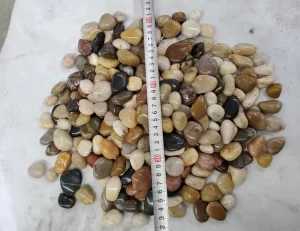Whether we are taking a leisurely walk along the coastline or meandering through a peaceful garden, our eyes are often attracted to the hypnotic variety of colours and textures that can be found in the works of nature. There are a number of intriguing aspects, one of which is mix colour pebbles, which are little stones that display a wonderful combination of colours, patterns, and forms. This collection of pebbles provides a look into the complex processes that are responsible for shaping the landscapes of our planet, which range from sandy beaches to stony riverbeds.
As part of our investigation, we set out on a quest to discover the secrets that lie behind the production of stones that have a mixture of colours. Our investigation delves deeply into the geological forces and environmental conditions that play a role in their formation, offering insight on the complex interaction between time, pressure, and the elements of nature. Beginning with the earliest deposition of sediments and continuing through the transformational impacts of erosion and weathering, each stage of the trip provides insights into the incredible variety and beauty of these natural marvels throughout the course of their existence.

First, a look at where the Mix Colour Pebbles came from.
It is necessary to investigate the origins of mix colour stones before we can comprehend how they come into existence. Riverbeds, beaches, and gravel deposits are some examples of geological phenomena that are often the source of these colourful stones. Erosion, weathering, and sedimentation are just some of the geological processes that have worked together over the course of millions of years to shape and polish these stones into their individual shapes.
In riverbeds, the persistent action of running water often results in the formation of stones of a variety of colours. In the process of winding their way across landscapes, rivers erode the rocks that are in their immediate vicinity, delivering shards of minerals and debris downstream. Over the course of time, the abrasive forces of water wear down and round these pieces, resulting in the formation of smooth, polished pebbles that range in size and colour for a variety of purposes.
The combined pressures of waves, tides, and coastal currents are responsible for the formation of pebbles of varying colours that are seen on beaches. Sand, gravel, and stones are carried along by the waves as they smash against the beach. These particles are then sorted and deposited along the coastline as the waves continue to crash against the shore. It is the continual action of the waves that helps to polish and shape these stones, so displaying their vivid colours and unique patterns.
The layers of sedimentary rock that make up gravel deposits include pebbles of varying colours that are lodged within them. These strata are subjected to the process of compaction and cementation over the course of millennia as a result of the pressure and heat that are deep under the Earth’s crust. This process transforms loose sediments into solid rock. As a result of geological processes like as tectonic activity and erosion, these rocks are being raised and brought to the surface, which causes them to reveal their hidden riches in the form of colourful pebbles.
The force of transformation is discussed in Part II.
Mix colour pebbles, after they have been produced, go through a number of transformational procedures that further increase their beauty and robustness. A variety of physical, chemical, and biological factors are involved in the process of weathering, which is one of the most important of these processes. Weathering is responsible for the gradual breakdown of rocks and minerals over time.
The process of physical weathering, which is sometimes referred to as mechanical weathering, takes place when rocks are broken down into smaller pieces as a result of the interactions of physical forces such as variations in temperature, frost action, and abrasion. There is a significant role that physical weathering plays in the process of smoothing and shaping the surfaces of mix colour pebbles. This process results in the creation of the distinctive rounded forms and polished textures that give these pebbles their captivating appearance.
The third kind of weathering, known as chemical weathering, is characterised by the transformation of minerals found inside rocks via the use of chemical interactions with water, acids, and other substances. There is a possibility that this process will result in the dissolution of certain minerals, the production of new minerals, and the modification of the textures and colours of rocks. Chemical weathering may lead to the leaching of soluble minerals, the deposition of secondary minerals, and the creation of brilliant colours and patterns in mix colour pebbles. These are all possible outcomes of the process.
On the other hand, biological weathering refers to the process by which living creatures, such as plants, fungi, and microbes, have an impact on the decomposition of rocks and minerals from the environment. Several different processes, such as the formation of roots, the activity of burrowing, and the release of organic acids, may all contribute to the occurrence of this process. In spite of the fact that biological weathering may not be as noticeable in pebbles with a variety of colours as it is in bigger rock formations, it is nevertheless capable of contributing to the progressive deterioration and transformation of these stones over the course of time.
Third Section: The Craftsmanship of Humans and Their Artistry
Pebbles that are mixed in colour go through a process that involves human involvement and workmanship in addition to being influenced by the forces of nature. Once these pebbles have been obtained from their natural sources, they may be picked, sorted, and treated in order to fulfil the aesthetic and functional needs of a variety of applications.
When it comes to landscaping and ornamental projects, mix colour pebbles are often categorised according to size, shape, and colour in order to create patterns and arrangements that are visually pleasing. Whether they are used to build mosaic artworks, to line garden walks or to highlight water features, these pebbles have been carefully selected to lend a touch of natural beauty to any outdoor location.
Mix colour pebbles are used in a wide number of applications within the area of interior design and architecture. These applications include anything from flooring and wall cladding to worktops and furniture. Using a combination of traditional craftsmanship and contemporary fabrication processes, craftsmen and designers are able to turn these simple stones into pieces that are both sophisticated and beautiful, so enhancing the visual appeal of both residential and commercial environments.

Concluding remarks:
The conclusion is that mix colour pebbles are not only ornamental accents or resources for landscaping; rather, they are stunning representations of the geological history of the Earth and the creative powers of nature. From their modest beginnings in riverbeds and beaches to their metamorphosis via weathering and human artistry, these stones exemplify the beauty, tenacity, and lasting appeal of natural materials. Their origins may be traced back to the beginnings of the earth. Mix colour pebbles continue to evoke wonder and admiration with their enduring beauty and allure, regardless of whether they are used to decorate a garden walk, enhance a mosaic artwork, or adorn the counters of a luxury kitchen.






